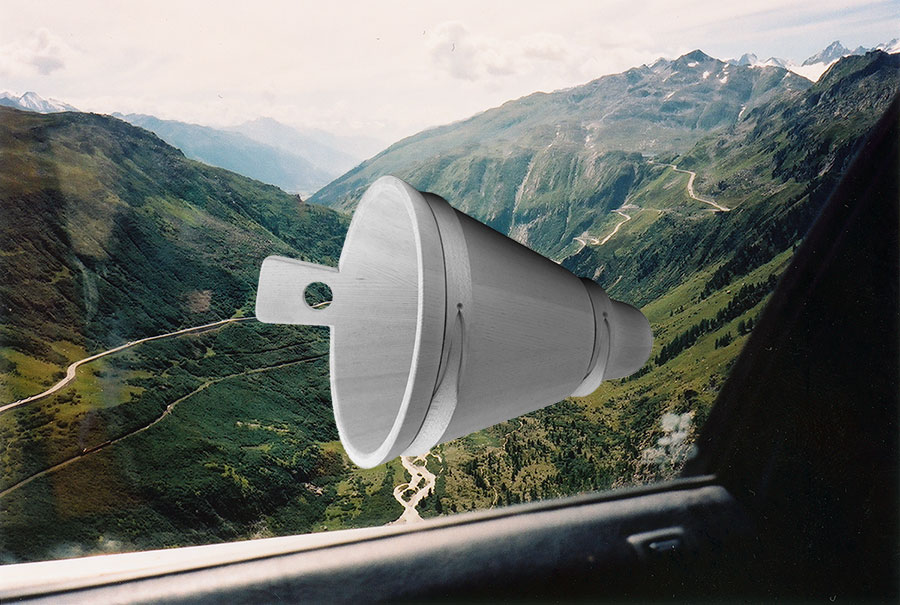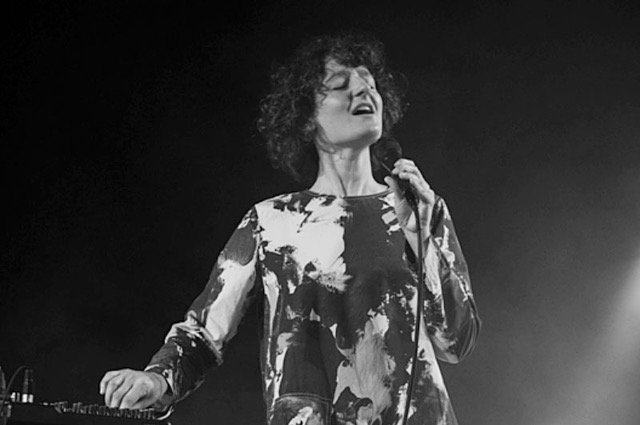After the Alpine Blessing
Michaela Schwentner, Nik Thoenen
Every evening, the alpine dairyman calls on heaven and saints to ask for protection for his alp and his cattle. Based on an existing prayer call, in our project we developed a site-specific and temporally relevant text and transferred it into contemporary context. The updated text has been reformulated into a secular appeal, which is not addressed to higher authorities, but, directed into the valley, demands a sense of responsibility from us humans.
We want to question this intangible cultural heritage, the prayer call or alpine blessing, as to its topicality: Does the ritual of calling for protection, originally reserved for men, still represent a functioning order in the Alpine region today? In our interpretation, an (alpine) dairymaid calls on us, society, to behave responsibly and mindfully towards nature.
Our project shifts context and orientation, involves an audience and is both performance and documentation. The performative act of the dairymaid and the technical act of recording her calls are to be seen as one coherent action.
We want to question this intangible cultural heritage, the prayer call or alpine blessing, as to its topicality: Does the ritual of calling for protection, originally reserved for men, still represent a functioning order in the Alpine region today? In our interpretation, an (alpine) dairymaid calls on us, society, to behave responsibly and mindfully towards nature.
Our project shifts context and orientation, involves an audience and is both performance and documentation. The performative act of the dairymaid and the technical act of recording her calls are to be seen as one coherent action.



Photo Credit: Nik Thönen
After the Alpine Blessing
In terms of topology, we are interested in a possible contextual shift of relations in model form. Our concept of topology is to be understood as an extended one, in which we perform a spatially-historically located event at a localised place, to which immaterial properties are attributed by user definition: a ritual, the basis of our investigations.
We are concerned with the Schutzruf (call for protection) as a fact*, as a form of communication on various levels. We are interested in this protective prayer chant, which was and still is practised as a ritual in Catholic parts of the Alps: every evening, the alpine herdsman and dairyman calls on heaven from his alp to ask for protection for his alp and his cattle.
The alpine blessing or prayer call is known in the cantons of Uri, Schwyz, Ob- and Nidwalden, Appenzell Innerrhoden, in the Pilatus region, Sarganserland, Upper Valais and Surselva (Grisons). We shifted the performance of ritual, the protection call, to another topological space, namely to the SARN to Conference 2022 site.
Starting from existing calls to prayer, we developed a site-specific and temporally relevant content and translated it into the present. We critically examined the current relevance of this intangible cultural heritage. How much does the ritual of the call for protection, which was originally a purely male domain, still reflect the social structure today, including that in the Alpine region? Thus, we have transferred the interpretation of a female performer who was supposed to shout the call from Realp into the Urseren Valley towards Andermatt. At this topologically specific site, the paths to the north, east, west and south cross and divide. In this respect, the chosen place Realp was symbolically a place that should reach the whole world via the Alpine passes (Oberalp, Furka and Gotthard) and the Göschenen Gorge.
We developed a site-specific and contemporary version based on existing calls and had a female caller performing the call down to the valley (instead up to the sky). By these means of transformation we question this intangible cultural heritage about its current relevance. To what extent does the ritual of calling for protection, which was originally a purely male domain, still reflect the social structure today, in particular that in the Alpine region?
Which lines could a prayer call contain in our times, what problems are inhabitants and managers of the Swiss Alpine region confronted with (the consequences of global warming, macroeconomic changes and developments, etc)? Which authority could be called today, who is responsible? Is it a question of guilt or responsibility? The Catholic tradition, which has used the apportionment of guilt as an instrument for executing and demonstrating power, delegates protective measures to so-called saints, to superior (supernatural) instances.
We suspended the delegation and direct the call towards the valley, to urban structures, densely populated regions, where the majority of society can assumed to be located, to take responsibility together with and in society** on one hand and on the other to demand it from current superordinate forms and instances**, such as supra-regional to supra-national associations, (climate responsible) politicians, the inhabitants of the Alpine region of the affected cantons, of Switzerland, of the earth - in other words, society as a whole. We mean both society in the sense of a social structure, the sum of all people, and society as a corporate form, which should pursue the implementation of the interests of different groups in harmony with nature and all people equally.
* The geo-object is identifiable, legally relevant space. The facts of a geo-object describe certain complex properties, such as the object ground (soil) and, as an attribute of this object, the facts of ground climate.
** In German, the term society is used for society as well as for companies, associations and corporations.
Click here to download the realruf
Listen to the recording of the Alpsegen:
In terms of topology, we are interested in a possible contextual shift of relations in model form. Our concept of topology is to be understood as an extended one, in which we perform a spatially-historically located event at a localised place, to which immaterial properties are attributed by user definition: a ritual, the basis of our investigations.
We are concerned with the Schutzruf (call for protection) as a fact*, as a form of communication on various levels. We are interested in this protective prayer chant, which was and still is practised as a ritual in Catholic parts of the Alps: every evening, the alpine herdsman and dairyman calls on heaven from his alp to ask for protection for his alp and his cattle.
The alpine blessing or prayer call is known in the cantons of Uri, Schwyz, Ob- and Nidwalden, Appenzell Innerrhoden, in the Pilatus region, Sarganserland, Upper Valais and Surselva (Grisons). We shifted the performance of ritual, the protection call, to another topological space, namely to the SARN to Conference 2022 site.
Starting from existing calls to prayer, we developed a site-specific and temporally relevant content and translated it into the present. We critically examined the current relevance of this intangible cultural heritage. How much does the ritual of the call for protection, which was originally a purely male domain, still reflect the social structure today, including that in the Alpine region? Thus, we have transferred the interpretation of a female performer who was supposed to shout the call from Realp into the Urseren Valley towards Andermatt. At this topologically specific site, the paths to the north, east, west and south cross and divide. In this respect, the chosen place Realp was symbolically a place that should reach the whole world via the Alpine passes (Oberalp, Furka and Gotthard) and the Göschenen Gorge.
We developed a site-specific and contemporary version based on existing calls and had a female caller performing the call down to the valley (instead up to the sky). By these means of transformation we question this intangible cultural heritage about its current relevance. To what extent does the ritual of calling for protection, which was originally a purely male domain, still reflect the social structure today, in particular that in the Alpine region?
Which lines could a prayer call contain in our times, what problems are inhabitants and managers of the Swiss Alpine region confronted with (the consequences of global warming, macroeconomic changes and developments, etc)? Which authority could be called today, who is responsible? Is it a question of guilt or responsibility? The Catholic tradition, which has used the apportionment of guilt as an instrument for executing and demonstrating power, delegates protective measures to so-called saints, to superior (supernatural) instances.
We suspended the delegation and direct the call towards the valley, to urban structures, densely populated regions, where the majority of society can assumed to be located, to take responsibility together with and in society** on one hand and on the other to demand it from current superordinate forms and instances**, such as supra-regional to supra-national associations, (climate responsible) politicians, the inhabitants of the Alpine region of the affected cantons, of Switzerland, of the earth - in other words, society as a whole. We mean both society in the sense of a social structure, the sum of all people, and society as a corporate form, which should pursue the implementation of the interests of different groups in harmony with nature and all people equally.
* The geo-object is identifiable, legally relevant space. The facts of a geo-object describe certain complex properties, such as the object ground (soil) and, as an attribute of this object, the facts of ground climate.
** In German, the term society is used for society as well as for companies, associations and corporations.
Click here to download the realruf
Listen to the recording of the Alpsegen:

Michaela Schwentner is artist, filmmaker, curator, lecturer at the Institute of Arts and Design at TU Vienna and operator of mosz records.
Her artistic focus is poetic transference of desire and the absent, historical or archived content. She works in the fields of moving image, performance, installation and site-specific intervention.
www.jade-enterprises.at
Her artistic focus is poetic transference of desire and the absent, historical or archived content. She works in the fields of moving image, performance, installation and site-specific intervention.
www.jade-enterprises.at

Nik Thoenen is an independent designer and has been involved in collaborations for various projects and interventions in the field of applied art. In 1999 he co-founded the Vienna-based collective re-p.org for interdisciplinary projects at the intersection of art and design, and 2007 the typeface platform Binnenland. His interest is in methods of using type, language and meaning as an instrument of understanding to concrete aesthetic action. Both in performative operation and as a haptic medium in a dramaturgy of content with its immanent spatial-temporal aspect, he places the sign at the centre of his examination, both formally and in terms of content. He is actually teaching at the Kunstuniversität in Linz.

Vera Baumann, *1988 Winterthur, lives and works in Lucerne (CH).
Contemporary singer and improvisor originating from Winterthur.
In 2020 she graduated with distinction from the Master's Performance in Jazz Singing at the University of Lucerne. She sings in various improvisation formations (including MingBauSet with Gerry Hemingway/Florestan Berset and Hobo Ho feat. Queen Unicorn with Hanspeter Pfammatter/Mario Castelberg/Pascal Widmer), collaborates in a quartet with yodeller Nadja Räss (stimmreise. ch 3), releases an EP with the Bernese quintet Hyla Crucifer ("Unidentifiable Birds", 2021) and is working on a piece for puppets, dance and voice with Chine Curchod and choreographer Teresa Rotemberg. With the visual artist Benjamin Heller, she realised an interactive sound installation at Jungkunst Winterthur in 2021 and at the Kunstpavillon Luzern in 2022.
www.verabaumann.com
In 2020 she graduated with distinction from the Master's Performance in Jazz Singing at the University of Lucerne. She sings in various improvisation formations (including MingBauSet with Gerry Hemingway/Florestan Berset and Hobo Ho feat. Queen Unicorn with Hanspeter Pfammatter/Mario Castelberg/Pascal Widmer), collaborates in a quartet with yodeller Nadja Räss (stimmreise. ch 3), releases an EP with the Bernese quintet Hyla Crucifer ("Unidentifiable Birds", 2021) and is working on a piece for puppets, dance and voice with Chine Curchod and choreographer Teresa Rotemberg. With the visual artist Benjamin Heller, she realised an interactive sound installation at Jungkunst Winterthur in 2021 and at the Kunstpavillon Luzern in 2022.
www.verabaumann.com